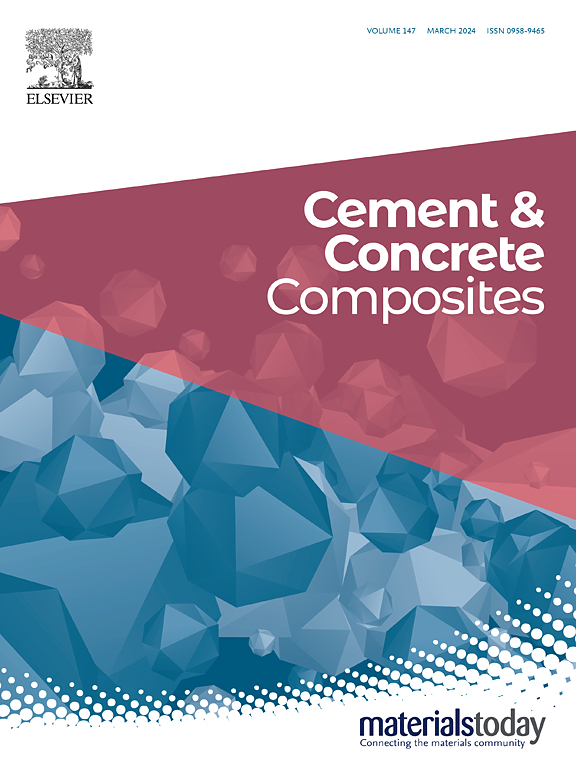Coupled mesoscale analysis of concrete shrinkage
IF 10.8
1区 工程技术
Q1 CONSTRUCTION & BUILDING TECHNOLOGY
引用次数: 0
Abstract
Cracking, driven by shrinkage and thermal strains, strongly influences the serviceability and durability of concrete structures. After several decades of use, cracking can cause structural deterioration and damage. Concrete shrinkage is sensitive to temperature and humidity variations in a complex hygrothermal environment. Therefore, an efficient numerical framework is essential to predict the structural response for all potential geometries and environmental conditions. This work presents a new multi-physics simulation framework coupling the mechanical behavior with chemical/physical processes of concrete while considering the meso-structure of concrete. The Lattice Discrete Particle Model (LDPM) is used the describe the mechanical response. The Hygro-Thermo-Chemical (HTC) model, which describes the moisture transport, heat transfer, and curing reaction, is solved using a flow lattice element (FLE) system dual to the mechanical mesh. The development of mechanical characteristics, as well as thermal and hygral eigenstrains owing to continued curing, is driven by the HTC model. In addition, a newly proposed 2-phase formulation for concrete shrinkage is introduced, considering the effect of aggregate volume and stiffness on concrete shrinkage. The results give robust predictions of macroscopic shrinkage for concretes with different mix proportions and indicate a better representation of meso-structural features than the previously proposed 1-phase formulation. To ensure the reliability of the results, five experimental campaigns from the literature were selected to calibrate and validate the numerical model. The model agrees well with the experimental data and offers new insights into local strain distribution and cracking behavior in heterogeneous materials at an acceptable computational cost.
混凝土收缩的耦合中尺度分析
开裂是由收缩和热应变引起的,严重影响混凝土结构的使用性能和耐久性。经过几十年的使用,开裂会导致结构恶化和损坏。在复杂的湿热环境中,混凝土收缩对温度和湿度变化非常敏感。因此,一个有效的数值框架对于预测所有可能的几何形状和环境条件下的结构响应至关重要。本文提出了一种新的多物理场模拟框架,在考虑混凝土细观结构的同时,将混凝土的力学行为与化学/物理过程耦合起来。采用点阵离散粒子模型(LDPM)来描述结构的力学响应。湿热化学(HTC)模型描述了水分传输,传热和固化反应,使用流动晶格元(FLE)系统解决了机械网格的双重问题。机械特性的发展,以及由于持续固化的热、水特征应变,是由HTC模型驱动的。此外,本文还介绍了一种考虑骨料体积和刚度对混凝土收缩影响的两相混凝土收缩公式。结果给出了不同配合比混凝土宏观收缩的稳健预测,并表明比先前提出的1相配方更好地代表了细观结构特征。为了确保结果的可靠性,从文献中选择了五个实验活动来校准和验证数值模型。该模型与实验数据吻合良好,在可接受的计算成本下为非均质材料的局部应变分布和开裂行为提供了新的见解。
本文章由计算机程序翻译,如有差异,请以英文原文为准。
求助全文
约1分钟内获得全文
求助全文
来源期刊

Cement & concrete composites
工程技术-材料科学:复合
CiteScore
18.70
自引率
11.40%
发文量
459
审稿时长
65 days
期刊介绍:
Cement & concrete composites focuses on advancements in cement-concrete composite technology and the production, use, and performance of cement-based construction materials. It covers a wide range of materials, including fiber-reinforced composites, polymer composites, ferrocement, and those incorporating special aggregates or waste materials. Major themes include microstructure, material properties, testing, durability, mechanics, modeling, design, fabrication, and practical applications. The journal welcomes papers on structural behavior, field studies, repair and maintenance, serviceability, and sustainability. It aims to enhance understanding, provide a platform for unconventional materials, promote low-cost energy-saving materials, and bridge the gap between materials science, engineering, and construction. Special issues on emerging topics are also published to encourage collaboration between materials scientists, engineers, designers, and fabricators.
 求助内容:
求助内容: 应助结果提醒方式:
应助结果提醒方式:


